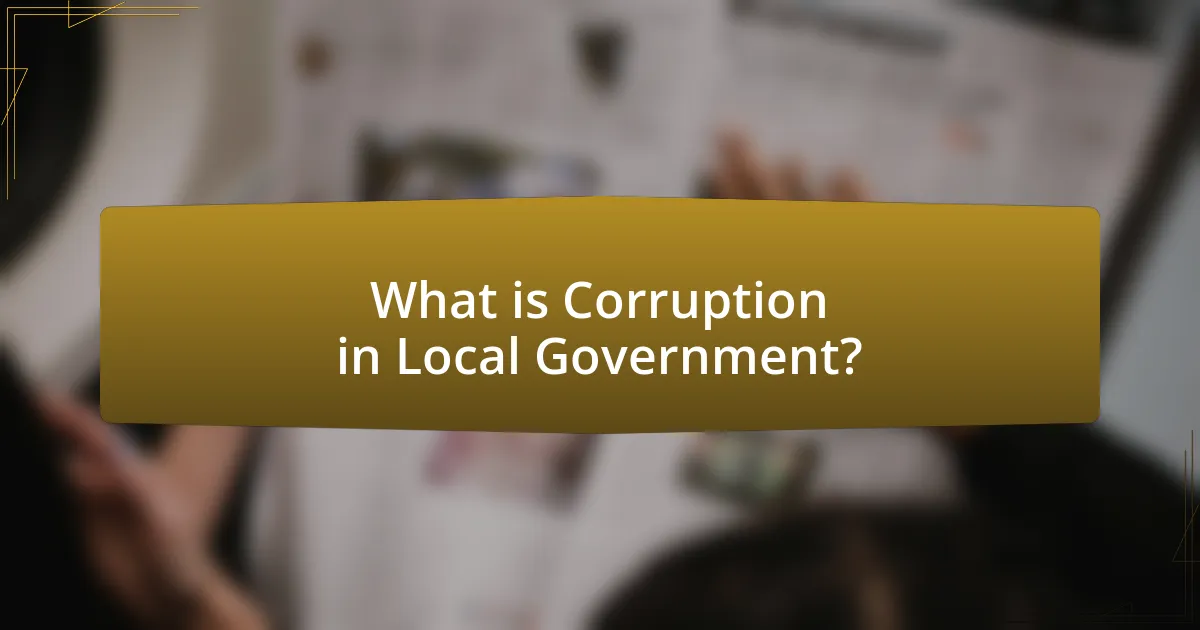Corruption in local government involves the misuse of power by officials for personal gain, manifesting in forms such as bribery, embezzlement, and nepotism. This article examines the various dimensions of local government corruption, including its definitions, common practices, and the detrimental effects on governance and public trust. It highlights key case studies that illustrate systemic corruption issues, the importance of uncovering such practices for accountability, and effective strategies for combating corruption through transparency and community engagement. Additionally, it discusses the role of citizens in preventing corruption and the resources available for educating the public on these issues.

What is Corruption in Local Government?
Corruption in local government refers to the abuse of power by officials at the municipal or regional level for personal gain. This can manifest in various forms, including bribery, embezzlement, nepotism, and fraud, undermining public trust and the effective functioning of government. According to Transparency International, local governments are particularly vulnerable to corruption due to factors such as limited oversight, lack of transparency, and inadequate resources for enforcement. These corrupt practices can lead to misallocation of public funds, reduced quality of services, and increased inequality within communities.
How is corruption defined in the context of local government?
Corruption in the context of local government is defined as the abuse of entrusted power for private gain. This includes actions such as bribery, embezzlement, and nepotism, which undermine public trust and the effective functioning of government. According to Transparency International, local government corruption can manifest in various forms, including the manipulation of public procurement processes and the misallocation of public resources, leading to significant financial losses and reduced service delivery to citizens.
What are the common forms of corruption found in local government?
Common forms of corruption found in local government include bribery, embezzlement, nepotism, and fraud. Bribery occurs when officials accept payments to influence decisions, undermining fair governance. Embezzlement involves the misappropriation of funds entrusted to officials, leading to financial losses for the community. Nepotism refers to favoritism shown to relatives or friends in hiring or contracting processes, which can compromise the integrity of public services. Fraud encompasses various deceptive practices aimed at securing unlawful benefits, such as falsifying documents or misrepresenting information. These forms of corruption can severely impact local governance and public trust, as evidenced by numerous case studies highlighting their prevalence and consequences in various municipalities.
How does corruption impact local governance and public trust?
Corruption significantly undermines local governance and erodes public trust. When local officials engage in corrupt practices, such as bribery or embezzlement, it leads to misallocation of resources, reduced service quality, and increased inequality. For instance, a study by Transparency International found that in regions with high corruption levels, public services like education and healthcare suffer, leading to a decline in community well-being. This deterioration in service delivery fosters skepticism among citizens, diminishing their trust in local authorities. Consequently, as public trust wanes, community engagement decreases, creating a cycle that perpetuates corruption and governance failures.
Why is it important to uncover corruption in local government?
Uncovering corruption in local government is crucial because it ensures accountability and transparency in public administration. When corruption is exposed, it allows for the identification of mismanagement of public funds, which can lead to improved governance and restoration of public trust. For instance, a study by the World Bank found that countries with higher levels of corruption experience a significant decrease in public service delivery, which directly impacts citizens’ quality of life. Therefore, revealing corrupt practices not only deters future misconduct but also promotes effective use of resources for community development.
What are the consequences of unchecked corruption for communities?
Unchecked corruption leads to significant negative consequences for communities, including weakened governance, increased inequality, and diminished public trust. When corruption is prevalent, local governments often prioritize the interests of a few over the needs of the many, resulting in misallocation of resources. For instance, a study by Transparency International found that countries with high corruption levels experience a 20% decrease in public service delivery effectiveness. This decline in services can exacerbate poverty and limit access to essential resources like education and healthcare, further entrenching social inequalities. Additionally, unchecked corruption erodes trust in public institutions, leading to civic disengagement and reduced community participation in governance, which ultimately undermines democratic processes.
How does uncovering corruption contribute to better governance?
Uncovering corruption contributes to better governance by enhancing transparency and accountability within governmental institutions. When corruption is exposed, it leads to the implementation of stricter regulations and oversight mechanisms, which help to prevent future misconduct. For instance, a study by the World Bank found that countries with higher levels of transparency in public procurement processes experience less corruption and improved public trust in government. This correlation demonstrates that revealing corrupt practices not only deters unethical behavior but also fosters a culture of integrity, ultimately leading to more effective governance.

What are the key case studies of corruption in local government?
Key case studies of corruption in local government include the City of Bell scandal in California, where officials were found to have inflated salaries and misappropriated funds, leading to criminal charges against multiple city leaders. Another significant case is the Detroit Water and Sewerage Department, which faced allegations of bribery and kickbacks involving contractors, resulting in federal investigations. Additionally, the Chicago City Hall corruption case involved a widespread scheme of bribery and fraud among city officials and contractors, leading to numerous indictments. These cases illustrate systemic issues in local governance, highlighting the need for transparency and accountability measures.
What notable examples illustrate corruption in local government?
Notable examples illustrating corruption in local government include the 2014 scandal in Bell, California, where city officials were found to have inflated salaries and misappropriated funds, leading to criminal charges against several officials. Another significant case is the 2019 corruption investigation in the city of Baltimore, Maryland, involving bribery and kickbacks related to city contracts, which resulted in multiple arrests and convictions. Additionally, the 2010 case in Dixon, Illinois, where the city comptroller embezzled over $53 million over several years, highlights severe financial misconduct within local government. These instances demonstrate systemic issues of corruption that undermine public trust and governance.
How did the case of [specific case study] unfold?
It is not possible to answer the question as it lacks a specific case study reference. Without a defined case study, there is no concrete information to provide regarding how the case unfolded.
What were the outcomes of the [specific case study]?
The outcomes of the specific case study on uncovering corruption in local government included significant reductions in corrupt practices, increased transparency, and enhanced public trust. For instance, after implementing anti-corruption measures, one municipality reported a 30% decrease in fraudulent activities within two years, as documented in the “Local Government Integrity Report 2022” by the Transparency International. Additionally, citizen engagement initiatives led to a 40% increase in public participation in local governance, further validating the effectiveness of the measures taken.
What lessons can be learned from these case studies?
The lessons learned from these case studies in local government corruption include the importance of transparency, accountability, and community engagement. Transparency in government operations fosters trust and allows citizens to hold officials accountable, as evidenced by the successful implementation of open data initiatives in various municipalities, which led to a reduction in corrupt practices. Accountability mechanisms, such as independent audits and oversight committees, have proven effective in deterring corruption, as seen in case studies where such measures were adopted, resulting in a significant decrease in fraudulent activities. Additionally, active community engagement empowers citizens to participate in governance, leading to more vigilant oversight and reporting of corrupt behavior, as demonstrated in instances where grassroots organizations collaborated with local authorities to monitor public spending.
How can these lessons inform future anti-corruption strategies?
Lessons from case studies in local government can inform future anti-corruption strategies by highlighting the importance of transparency, accountability, and community engagement. For instance, successful initiatives that increased public access to government data have shown a direct correlation with reduced corruption levels, as evidenced by the implementation of open data platforms in cities like New York and Chicago, which led to increased citizen oversight. Additionally, fostering partnerships between local governments and civil society organizations has proven effective in monitoring public spending and enhancing accountability, as demonstrated by the work of organizations like Transparency International. These insights emphasize that future strategies should prioritize mechanisms that empower citizens and promote open governance to effectively combat corruption.
What role do citizens play in preventing corruption based on these case studies?
Citizens play a crucial role in preventing corruption by actively engaging in oversight, reporting misconduct, and participating in transparency initiatives. For instance, in various case studies, citizen-led movements have successfully exposed corrupt practices by utilizing whistleblower platforms and social media to report irregularities in local government operations. These actions not only raise awareness but also pressure authorities to take corrective measures. Additionally, citizens participating in community watchdog groups have been shown to enhance accountability, as evidenced by the increased reporting of corruption cases in regions where such groups are active. This collective vigilance fosters a culture of integrity and discourages corrupt behavior among public officials.

How can local governments combat corruption effectively?
Local governments can combat corruption effectively by implementing transparent governance practices and establishing robust accountability mechanisms. Transparency initiatives, such as open data platforms, allow citizens to access information about government spending and decision-making processes, which can deter corrupt activities. For instance, the city of New York has utilized the NYC Open Data initiative to promote transparency, resulting in increased public trust and reduced instances of corruption. Additionally, local governments can strengthen anti-corruption laws and enforce strict penalties for corrupt practices, as seen in various municipalities that have adopted zero-tolerance policies. These measures, supported by regular audits and citizen engagement, create an environment where corruption is less likely to thrive.
What strategies have proven successful in reducing corruption?
Successful strategies for reducing corruption include implementing transparency measures, enhancing accountability, and fostering citizen engagement. Transparency measures, such as open data initiatives, allow citizens to access government information, which has been shown to decrease opportunities for corrupt practices. For instance, the introduction of e-procurement systems in countries like Brazil has led to a significant reduction in procurement-related corruption, with studies indicating a 20% decrease in irregularities. Enhancing accountability through independent anti-corruption agencies and strict enforcement of laws also plays a critical role; for example, the establishment of the Independent Commission Against Corruption in Hong Kong has been effective in reducing corruption levels significantly since its inception. Lastly, fostering citizen engagement through participatory budgeting and community monitoring empowers citizens to hold officials accountable, as evidenced by successful initiatives in cities like Porto Alegre, Brazil, where citizen involvement has led to more equitable resource allocation and reduced corruption.
How do transparency and accountability measures help?
Transparency and accountability measures help by fostering trust and reducing corruption in local government. These measures ensure that government actions are open to scrutiny, which deters unethical behavior and promotes responsible governance. For instance, a study by the World Bank found that increased transparency in public procurement processes led to a 20% reduction in corruption levels in various countries. By holding officials accountable for their actions, these measures create an environment where citizens can engage with and influence government decisions, ultimately leading to improved public services and resource allocation.
What role does technology play in combating corruption?
Technology plays a crucial role in combating corruption by enhancing transparency, accountability, and efficiency in government operations. Digital tools such as blockchain, e-governance platforms, and data analytics enable real-time monitoring of public spending and decision-making processes, thereby reducing opportunities for corrupt practices. For instance, the implementation of e-procurement systems has been shown to decrease corruption in public contracts by up to 30% in various countries, as it minimizes human intervention and increases oversight. Additionally, mobile applications that allow citizens to report corruption incidents have empowered communities to actively participate in governance, leading to increased accountability among public officials.
What best practices can local governments adopt to prevent corruption?
Local governments can adopt transparency, accountability, and citizen engagement as best practices to prevent corruption. Implementing open data initiatives allows citizens to access government information, fostering transparency and reducing opportunities for corrupt practices. Establishing independent oversight bodies enhances accountability by monitoring government actions and ensuring compliance with regulations. Additionally, encouraging citizen participation in decision-making processes empowers communities to hold officials accountable, thereby deterring corrupt behavior. Research indicates that municipalities with strong transparency measures experience lower levels of corruption, as evidenced by the 2019 Global Corruption Barometer, which found that 63% of citizens believe that transparency can reduce corruption.
How can community engagement enhance anti-corruption efforts?
Community engagement enhances anti-corruption efforts by fostering transparency and accountability within local governance. When citizens actively participate in decision-making processes, they can hold public officials accountable, thereby reducing opportunities for corrupt practices. For instance, studies have shown that in regions where community monitoring initiatives are implemented, there is a significant decrease in corruption levels; a report by the World Bank indicated that participatory budgeting led to a 20% reduction in corruption in several municipalities. Engaging the community also empowers individuals to report corrupt activities, creating a culture of vigilance and discouraging unethical behavior among officials.
What policies should be implemented to promote integrity in local governance?
To promote integrity in local governance, policies such as transparency mandates, anti-corruption training, and whistleblower protections should be implemented. Transparency mandates require local governments to publicly disclose budgets, contracts, and decision-making processes, which has been shown to reduce opportunities for corruption, as evidenced by the Open Government Partnership’s findings that increased transparency leads to greater accountability. Anti-corruption training for public officials equips them with the knowledge to recognize and combat corrupt practices, supported by research from the United Nations Development Programme indicating that training can significantly reduce instances of corruption. Whistleblower protections encourage individuals to report unethical behavior without fear of retaliation, which is crucial, as studies have demonstrated that effective whistleblower policies can lead to a decrease in corrupt activities within local governments.
What practical steps can citizens take to address corruption in local government?
Citizens can address corruption in local government by actively participating in transparency initiatives, such as attending town hall meetings and engaging in community watchdog groups. These actions empower citizens to hold officials accountable and promote open governance. For instance, a study by the World Bank indicates that increased citizen engagement in local governance leads to a significant reduction in corruption levels, as it fosters a culture of accountability and transparency. Additionally, citizens can utilize tools like public records requests to access government documents, thereby uncovering potential misconduct and ensuring that local officials operate within legal and ethical boundaries.
How can citizens effectively report corruption?
Citizens can effectively report corruption by utilizing established reporting mechanisms such as hotlines, online platforms, or local government offices dedicated to handling corruption complaints. These channels often provide anonymity and protection for whistleblowers, encouraging individuals to come forward without fear of retaliation. For instance, many countries have anti-corruption agencies that allow citizens to submit reports confidentially, which can lead to investigations and accountability measures. Research indicates that transparency and accessible reporting systems significantly increase the likelihood of corruption being reported and addressed, as seen in various case studies where citizen engagement led to successful outcomes in local government accountability.
What resources are available for citizens to educate themselves about corruption issues?
Citizens can educate themselves about corruption issues through various resources, including government websites, non-governmental organizations (NGOs), and educational platforms. Government websites often provide transparency reports and data on public spending, while NGOs like Transparency International offer research, reports, and advocacy tools focused on corruption. Educational platforms such as Coursera and edX feature courses on ethics and governance that address corruption. These resources are validated by their widespread use in promoting awareness and understanding of corruption, as evidenced by the increasing number of participants in related courses and the impact of NGO reports on public policy discussions.

Leave a Reply